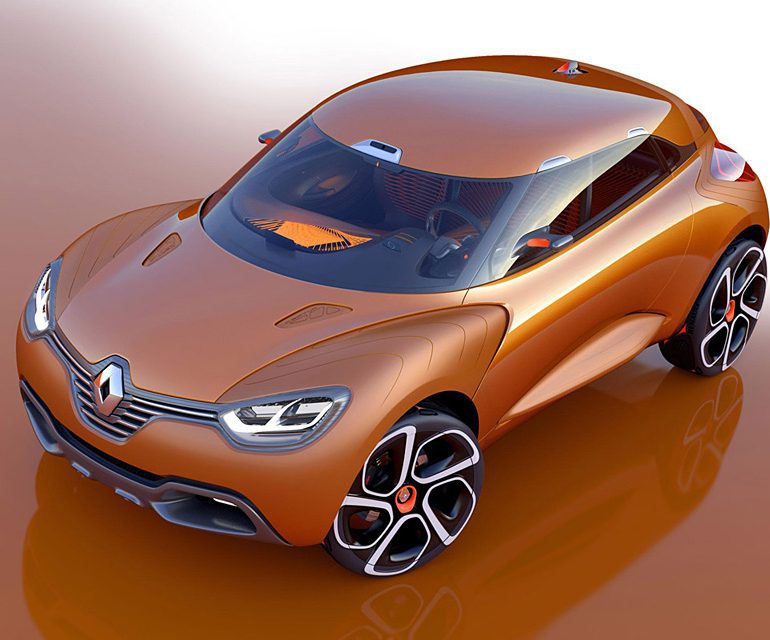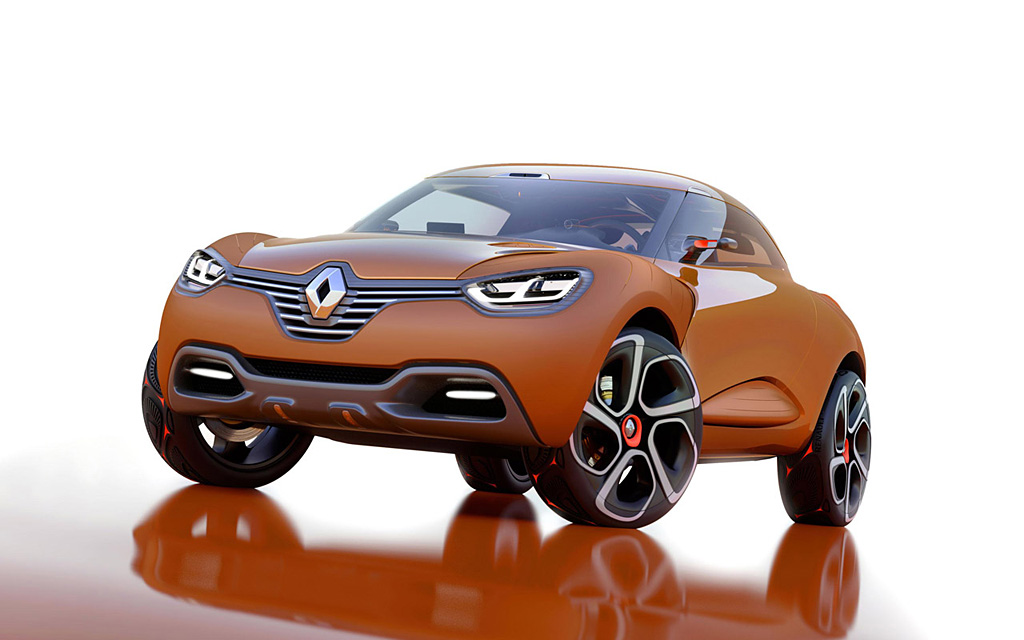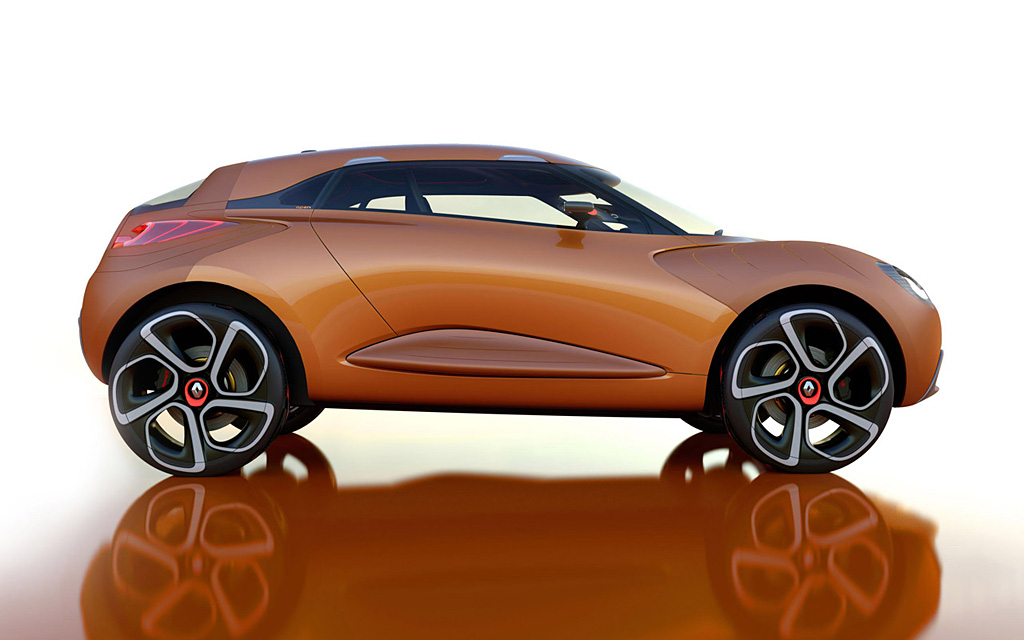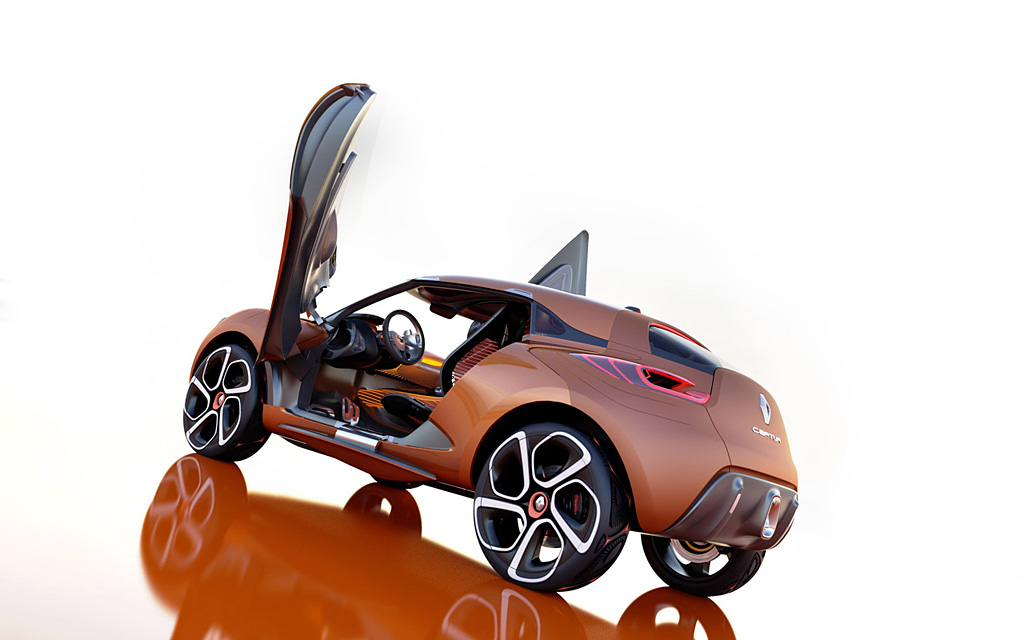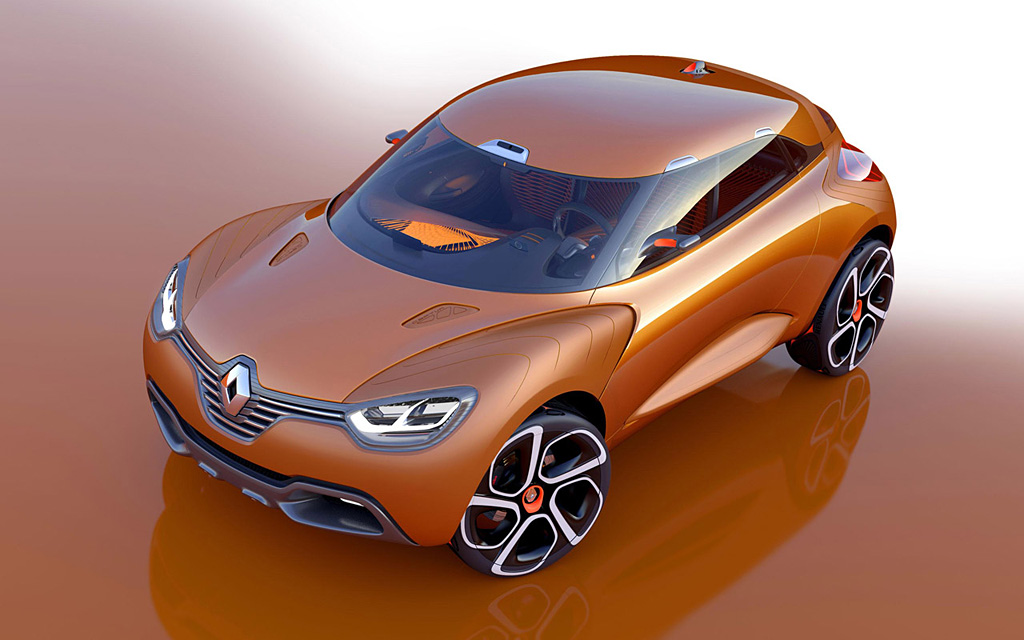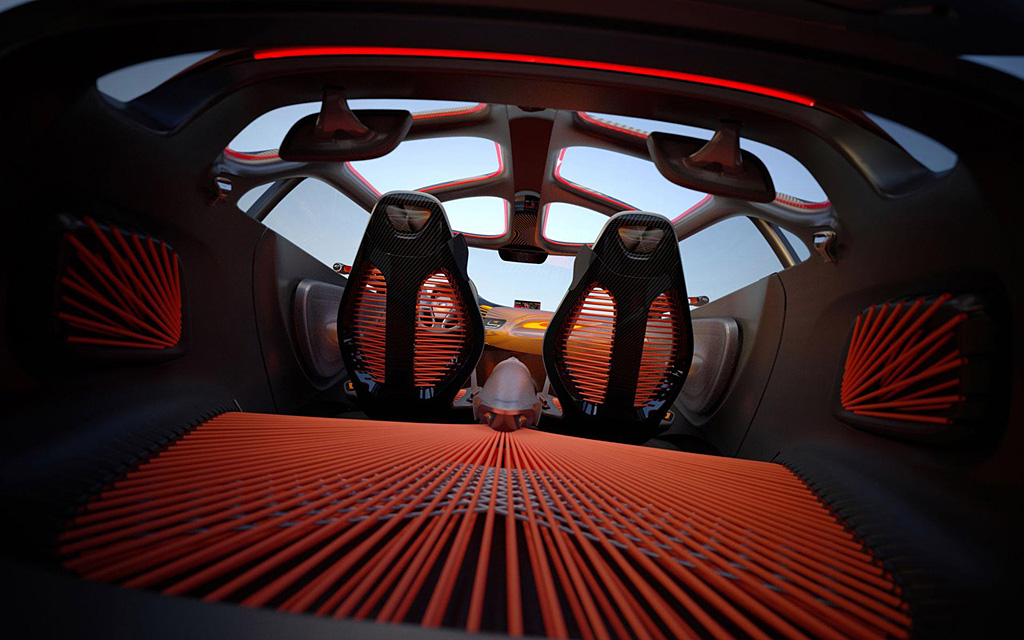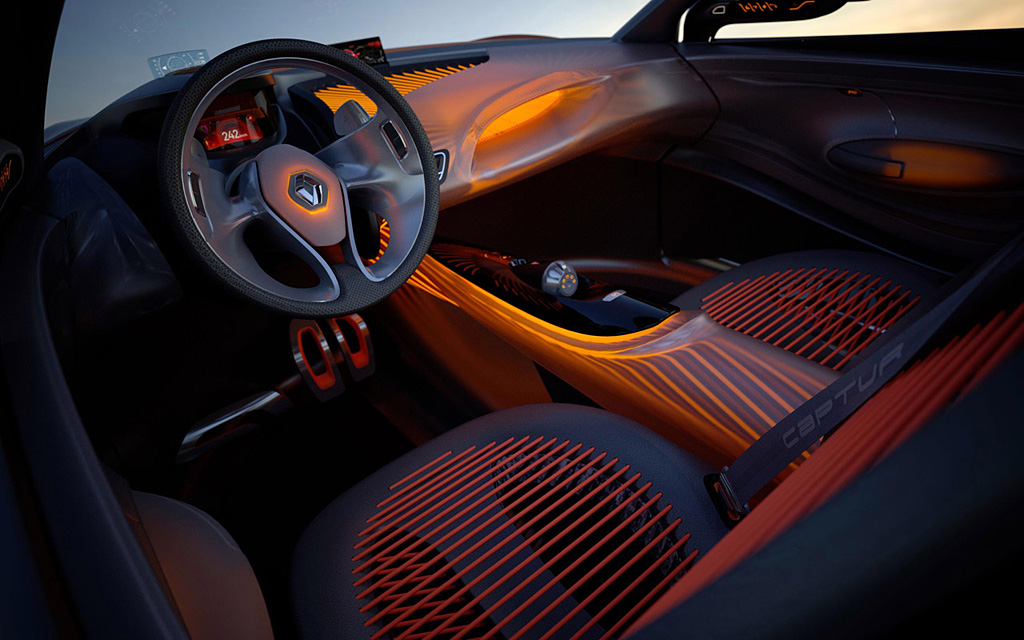2011 Renault CAPTUR
At the 2009 Frankfurt Motor Show, Renault revealed its new brand identity which puts people at the forefront of its concerns. The new and ambitious design strategy which resulted from this is founded on different stages of the human life cycle, with each phase taking the form of a specific concept car. The first, the two-seater DeZir coupé, expressed ‘falling in love’, the passion present at the beginning of any new adventure. Now Renault CAPTUR addresses the second phase of this cycle, that of two people exploring the world around them.
Just like its predecessor, Renault CAPTUR defines the simple, sensuous and warm style that will be progressively extended to future Renault car designs. “CAPTUR is a fun and sporty crossover, ideal for a young couple about to discover the world” explains director of design, Laurens Van den Acker. “It takes as its basis the fundamental design language introduced on the DeZir concept car but adds a more technical dimension – more functional but still highly sensuous,” adds Axel Breun, director of concept cars.
A CROSSOVER THAT’S ALL MUSCLE IN MOTION
In its proportions and fluid curves, Renault CAPTUR evokes movement and lightness, yet at the same time displaying powerful and muscular all-terrain cues. Just as with DeZir, angles, corners and lines have given way to sensuous and natural forms. For the exterior designer, Julio Lozano, the main sources of inspiration were athletes and radical sports. “In designing CAPTUR, I began with the image of a sprinter on the starting blocks, his muscles tensed, and the energy unleashed when the starting pistol is fired,” he explains. The design also references equipment such as helmets, gloves and other protective gear used in radical sports, combining high technology with sophistication and lightness.
Renault CAPTUR adopts the new frontal identity first presented by DeZir. As with DeZir, this identity has as its centrepiece a large Renault logo, set vertically against a dark surface so as to stand out as clearly as possible. Substantial, matt-finished wings reinforce the design’s visual strength. LEDs relay the direction indicator signal in a wave effect running the whole length of the vehicle.
Renault CAPTUR does more than simply stir the emotions: it is also a practical and versatile vehicle. It is fitted with a hard convertible top which, once removed, reveals a carbon fibre framework. CAPTUR can thus transform itself from a coupé to a convertible, from an urban vehicle to an off-roader, while its overall sporty appeal is reinforced by its butterfly doors and big tyres fitted to 22-inch black and white rims. With its bodywork finished in a spicy shade of orange, CAPTUR takes its cue from the red championed by DeZir. This colour appears in a variety of different shades on materials both inside and outside the vehicle.
AN INTERIOR FULLY BATHED IN WARMTH AND LIGHTNESS
The orange theme has been carried over to the cabin which also features fluorescent highlights picked out by a constant stream of light. “My main sources of inspiration were the human body, outdoor sports and urban styling,” explains the colour and trim designer, Kana Watanabe. “I wanted CAPTUR to radiate warmth and dynamism.”
The interior of Renault CAPTUR is designed to be both welcoming and occupant-friendly.
The impression of lightness expressed by the exterior is dominant here, too, with the front seats attached to the centre console as if suspended in mid air. The passenger compartment is restrained and pure, with no superfluous equipment. Innovative and ingenious materials have been employed, allowing the designers to play with light and optical effects. The centre console, door casings and dashboard are formed using a translucent material rather like a second skin. At the front of the cabin, this includes a glimpse of the high-tech fibre ropes, luminescent in places, that have been used for most of the passenger compartment. “The whole of the interior is designed around this network of stretched elastic ropes which bring to mind the worlds of sailing or mountain climbing, They use graphics and light to bring rhythm to the overall design and reinforce the dynamic feel of the vehicle while also ensuring a lighter feel inside the cabin,” explains the interior designer, Magali Gouraud-Borgers.
The aluminium pedals, carbon bucket-style front seats and steering wheel trimmed in grey textured leather reassert the sporting side of the design, in keeping with the original brief.
The rear of the vehicle is a multipurpose area where the deck is lined with three layers of rope:
The rear of the vehicle is a multipurpose area where the deck is lined with three layers of rope:
* The stretched cords are laid out in a way that allows items to be secured, thus providing a reconfigurable storage area;
* They also provide an opportunity for relaxation thanks to the supple elasticity of the structure. This is an entirely new type of comfort, a new form of seating akin to a hammock.
* Finally, it is possible to pull seatbacks from the side of the car to provide two full-sized rear seats, complete with seat belts and head restraints. This enables CAPTUR to accommodate four passengers.
AN INNOVATIVE CROSSOVER THAT’S STRONG ON PERFORMANCE AND LIGHT ON FUEL
AN INNOVATIVE CROSSOVER THAT’S STRONG ON PERFORMANCE AND LIGHT ON FUEL
Renault CAPTUR makes use of the Energy dCi 160 twin-turbo engine-concept, developed from the new Energy dCi 130. Downsizing is a key element in Renault’s strategy to meet its declared objective of being Europe’s leading automaker with regard to CO2 emissions. The range of electric vehicles will run alongside internal-combustion engined models that combine performance with reduced fuel consumption. Energy dCi 160 twin-turbo fits perfectly within this strategy. It produces 118kW (160hp) from a capacity of 1.6 litres – that’s a specific power output of 100hp per litre. Peak torque (380Nm) is available from as low as 1,750rpm, giving powerful acceleration from low revs, as well as refined performance under all driving conditions. Paired with a dual clutch EDC gearbox, this driveline promises genuinely enjoyable driving with CO2 emissions of 99 g per kilometre.
Renault CAPTUR’s performance is further enhanced by the RX2®, a novel system that improves traction at low speeds. Should one of the two driven wheels lose traction, this entirely new mechanical self-locking differential transfers all or part of the engine’s torque to the wheel with the most grip. Driving on slippery roads and tracks thus remains smooth and effortless.
Renault CAPTUR also marks the debut of the Visio-system, an innovation that uses a forward-facing camera mounted at the top of the windscreen to provide driver-assistance functions. This new technology is able to embed synthesised images into real-time images of the road ahead displayed on a central screen; this is the principle of augmented reality, aiming to enhance the driver’s perception of the external world by superimposing purpose-designed elements. The system helps reduce driving stress, for a relaxed, reassuring ride.
The new design strategy takes as its basis the bonds that build between the brand and its customers as they go through the many experiences of life: when they fall in love, begin to explore the world, start a family, work take time off to play, and gain wisdom.
This goes hand in hand with the definition of a new human design language inspired by the three keywords that guide the brand’s future vision: simple, sensuous and warm. In keeping with this strategy, concept cars will be instrumental in putting shape to this vision, paving the way for a product plan featuring a clear and consistent range of models.
In Detail
| type | Concept / Prototype Car |
| released at | 2011 Geneva Motor Show |
| coachbuilder | G Studio Body |
| engine | Energy dCi 160 Inline-4 |
| aspiration | Twin-Turbo |
| displacement | 1598 cc / 97.52 in³ |
| power | 118 kw / 158.2 bhp |
| specific output | 99.0 bhp per litre |
| bhp/weight | 121.69 bhp per tonne |
| torque | 380 nm / 280.3 ft lbs |
| front tires | 250/40 R22 Michelin |
| rear tires | 250/40 R22 Michelin |
| curb weight | 1300 kg / 2867 lbs |
| wheelbase | 2624 mm / 103.3 in |
| front track | 1684 mm / 66.3 in |
| rear track | 1684 mm / 66.3 in |
| length | 4223 mm / 166.3 in |
| width | 1950 mm / 76.8 in |
| height | 1586 mm / 62.4 in |
| tran clutch | EDC (Efficient Dual Clutch) |
| top speed | ~210 kph / 130.41 mph |
| 0 – 100 kph | ~8.0 seconds |
| drag | 0.31 Cd |
| emission | 99 g/km |


